|
Intersections: Gender and Sexuality in Asia and the Pacific
Issue 50, December 2023 doi: https://doi.org/10.25911/QVSC-0K69 |
|
A Study of the Cop Saga of Bollywood Pallavi Panda, Vasava Mithunbhai Gambhirbhai and Urvashi Kaushal Introduction Film is a multifaceted art form and cultural institution with an impact that spans and exceeds the twentieth century;[1] however, films work as 'businesses' to accumulate wealth instead of 'presenting themselves as art'[2]—an effect of the global economic system underpinned by neoliberal ideology. Although neo-liberalism is a model of capitalism that favours deregulating the market, a decline of state intervention in economic and social affairs,[3] apart from regulating economic activities of labour and consumption, the ideology is extended to non-monetary activities to configure human beings as 'market actors.'[4] As a result, people are subjected to the power of neoliberal capitalism, its pervasive effect on their private lives, gendered bodies and consciousness.[5] Out of all gendered bodies, keeping 'masculine hero' in films under focus, the arguments of the paper will be limited to masculinity and the male body. Masculinity in the neoliberal capitalist setting can be studied in terms of its relation to 'emerging dominant powers in the global capitalist economy, the transnational corporations.'[6] Contrary to the high profit making of the capitalist corporations, the workers are pushed more to the periphery with lower pay, less security and less economic stability.[7] Referring to this inequality of class position, Charlie Walker and Steven Roberts argue that men's 'cultural practices' in terms of leisure and consumption provide alternative spaces fit for constructing those aspects of masculinity that are repressed in the work place.[8] This act of consumption underscores the emergence of a cultural production that exhibits traditional and ideal masculine traits such as, virility, strength, body aesthetics amidst the ever shifting economic and familial roles for men.[9] We extend this argument to portrayal of masculinity in post-1990 Hindi films, when economic liberalisation has fully exposed 'Indian markets to global capital and consumerism' since 1991.[10] Matching neoliberal ideology, films become sellable products in need of packaging, branding and marketing in front of a predetermined audience by corporate-led production houses.[11] Furthermore, in this framework of capitalist economy, films require a 'specific mode of representation,'[12] which comprises commodification of certain aspects of culture or society for commercial returns and renders the showcase of creativity secondary.[13] Similarly, the paper will highlight the politics of presentation associated with cop heroes in order to show how repetition in production and mass consumption leads to a commodification of masculinity. Commodity in Marxian terms refers to a thing which 'satisfies human wants of some sort or another,'[14] and the value of commodity is decided by what society designates as valuable.[15] In a neoliberal capitalist society, the male body works as a 'capitalist commodity' that is 'metaphorically bartered, segmented, marketed and sold' in cultural productions including films made and produced in the Hindi film industry or Bollywood,[16] as it is popularly called. Building upon these concepts and keeping the trope of the cop hero under focus, this paper aims to study how a particular pattern of masculinity has been used and marketed as a commodity that is mass consumed by the audience which results in the reception of a singular form of masculinity. Hindi films which largely depicted the male lead character as a romantic hero or a harbinger of social change until the 1970s saw a paradigm shift with the screenwriting duo, Salim Khan and Javed Akhtar, who set the trend of cop hero with films like Zanjeer (Shackles, 1973) and Deewaar (The wall, 1975).[17] Following this trend, Hindi cinema industry has produced unforgettable cop heroes in Sholay (Embers, 1975),[18] Tirangaa ( Tricolour, 1993),[19] Main Khiladi Tu Anari (Me, the player, you, the novice, 1994),[20] Kurukshetra (Battle field, 2000),[21] Gangaajal (Holy water, 2003),[22] Rowdy Rathore (2012).[23] In addition to these films, many cop movies are tagged as Blockbuster movies under Bollywood (a term recently in use incorporating a corporate logic). These cop films have one of three common themes: a good cop fighting against a corrupt system to kill the villain, a bad cop who becomes good in the end to fight the villain, or a bad cop who kills the villain for the benefit of the masses. In reference to the plot of the cop-action genre, Jeffrey Brown describes the narrative formula in three acts: the first act introduces the hero, the villain and the main characters; the second act brings out the conflict inherent to the story, and the third act resolves the conflict, and sees the hero victorious.[24] Such themes and plot structures that depict the adventures of mostly men in police uniform (women are included in a few cases) unite the movies under one tag: cop saga. However common the story may be, the continuing popularity of this genre, suggests how Bollywood continues to popularise the cop culture with certain formulas, simultaneously stimulating the viewers' interest and matching their demands with strategies of profit making. Hence, this paper argues that Bollywood's use of such extravagant capital put into movie making to repeatedly showcase the masculinity of police officers, turns films into a commodity and not art. Moreover, it concentrates on certain formulaic productions of Rohit Shetty's trio Singham (The lion, 2011),[25] Simmba (2018)[26] and Sooryavanshi (2021),[27] taking into account the projection of the powerful male body, a display of unwarranted violence, and representation of the hero as the protector, in order to establish that the need for a consumable hero affects the representation of masculinity, and its reception among the audience. Projection of the powerful male body Shetty's films depict a dualistic masculinity on the screen, contrasting heroic masculinity marked by civic values, nationalist fervour and physical virility against the villain's anti- national, anti-social acts. This section will focus on heroic masculinity articulated through the trope of the muscular body. Heroic masculinity, central to the structure and theme of many Bollywood films, has been depicted by a larger-than-life protagonist, who stands for good, and emerges victorious in the end.[28] Similarly, in Shetty's films, representation of the cop hero works through exaggerated display of violence, aggression and a muscular body. The image of the muscular hero in Indian cinema gained prominence around the 1990s when socialist goals were replaced by economic liberalisation, which opened up new avenues for displaying the male body through 'new bodily dispositions and practices.'[29] As an effect of unequal economic development in a repressive neo-liberal capitalist structure, both Michael Kimmel and Lee Clark Mitchell argue that the gap between the image of 'atavistic ideal masculinity' and the reality of bureaucratic conformity is compensated through consumption of an imagined self-reliant, powerful man.[30] Since the spectatorship for such films portraying the ideal masculinity is implicitly heterosexual male, the heterosexual gaze has been applied to the screen; consequently, the homoerotic element is repressed, and the female as a sexual object is projected. That said, the male body is projected with strength and virility.[31] Therefore, the muscular male body becomes a crucial space for registering and maintaining sexual differences and gender practices. First, the male body projected in Singham is lean but well-structured, well-endowed with muscles, carefully toned and manicured. The film's depiction of the male protagonist, praying to God with a bare body emerging from the water highlights masculinity based on muscularity (see Figure 1). Furthermore, instead of seeing the body as a personal projection of individual concern and ideas, it is important to consider the body as a 'process' constantly changing and moving aligned with the historical and social context.[32] Consequently, the heroic body represents a 'global imagistic of masculinity' in Hindi cinema of the post-liberal period.[33] Hence, even though the male hero is placed in a religious setting, offering prayer, the body adheres to bodily aesthetic ideals that are 'globalised' in nature.[34] The changing situation in India demands a 'new' man who follows the globalised body ideal through the gym culture in an urban landscape.[35] This urban culture of sports and the gym further contributes to shaping 'male selfhood and physique of the hero,'[36] and creates a heteronormative, quintessential male body, which is here exemplified by a bare torso and well-sculpted arms(see Figure 1). 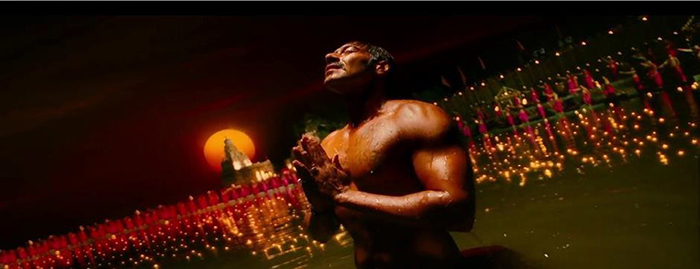
Figure 1. Representation of the 'ideal' male body. Source. Still from Singham, 0:08:12. The heroic body becomes the projection of aspirational fantasy ideals of masculinity[37] or 'hegemonic masculinity,' which comes into play when cultural ideals and institutional power are wedded together.[38] Hegemonic masculinity is considered as the 'most honoured way of being a man,' but does not refer to a set of characteristics; moreover, it is configured upon a range of ways, and normative patterns depending on the social context.[39] Accordingly, the hero's physique is carefully calibrated, beautified with water flowing from his gleaming body fostering the dominant practices and values (see Figure 1). It becomes a desirable body that incorporates a 'hegemonic vision of what the [male] body should be,'[40] and corresponds to only a small percentage of the male population in reality. However small the percentage may be, bodies representing hegemonic masculinity are naturalised through film heroes, sagas, ballads, thrillers and so forth among the masses,[41] and such 'embodied masculinity' becomes an inspirational model for young men in 'new' India.[42] The reception of the heroic body as an ideal masculine body is a result of the 'structure of fascination' as Laura Mulvey puts it, since it leads to a 'temporary loss of the [viewer's] ego,' and reinforcement of it through identification with an 'ego ideal' on the screen.[43] Mulvey has used Jacques Lacan's theory of the imaginary-symbolic-real triad,[44] to suggest that just as children consider their mirror image to be more 'complete,' the heroes on screen fulfill the roles of 'ego ideals' for the audience playing out 'complex process of likeness and difference.'[45] As a result, they appear on screen as larger-than-life characters for the audience, projected as the ideal image to be consumed.[46] Furthermore, while Megha Kadam warns antagonist Jaykant Shikre that God will avenge his sin of killing her husband, this shot (see Figure 1) of introducing the protagonist establishes Singham's position as a god-like figure. It suggests that it is the body of the cop onto which the image of the avenger is projected, for the 'corporeal presence' with muscularity acts as a 'strategic weapon' that extends the threat of violence even when it is not enacted in this frame (see Figure 1).[47] Second, Simmba introduces the male hero as a macho man in a black shirt, with black goggles, groomed hair and a moustache with a clean oily shine. He chases down the robbers. His invigorating entry in the film demonstrates a police officer's vitality, perseverance, strength, discipline, toughness, bravery and assertiveness. The background music rises when Simmba's forceful kick sends the robber flying into the air to finally drop down in a water vessel, and another kick sets the water vessel in motion. The combination of all these elements denotes a larger-than-life representation of heroism in popular culture, which is a result of sensational excitement, violence, melodrama and a larger ambition used together.[48] Moreover, the charisma of heroic masculinity—a product of viewers' 'deepest desires'[49] influenced by discourses of fashion, urban culture of gym and sports—is enacted here (see Figure 2) on the 'physique and selfhood' of the cop hero.[50] 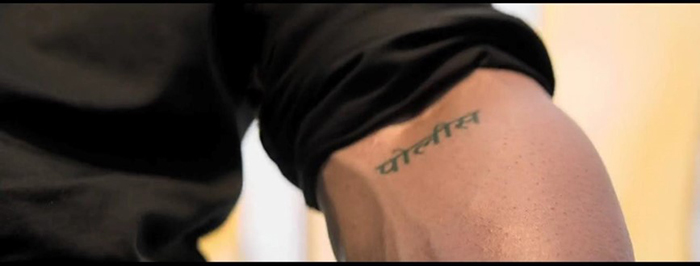
Figure 2. Representation of the muscular body with the tattoo 'police.' Source. Still from Simmba, 0:07:01. The male body is given visibility through different camera angles, such as a side angle that focuses on his torso and sharp jaw line. Further, the male body is kept at the centre with a half-buttoned black shirt that reveals his well-sculpted chest muscles. The camera angle with an extreme close-up shot displays pulsating forearm where a tattoo of 'police' is written in Hindi (see Figure 2). Such a brawny physique is not only culturally and socially celebrated, but it is also legitimised as a site for physical and social power,[51] which rightly gets reflected by the tattoo. The display of prowess by a muscular body, a fighting scene and extravagant action moves appears to be a part of the representational politics carried out to build a larger-than-life hypermasculine body, which has the power to instill pain on other bodies with or without any weapons.[52] 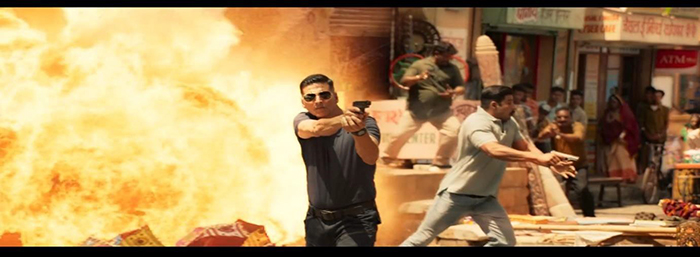
Figure 3. Hypermasculine hero invulnerable to fear and danger. Source. Still from Sooryavanshi, 0:13:50. Third, the scene of arresting the terrorist Riyaaz Hafeez is depicted by using exaggerated stunts. In Sooryavanshi—this is achieved with the explosion of vehicles, and an incessant firing of guns. It also shows the hero, being invulnerable to the explosion, engaged in sole combat with the terrorist (see Figure 3). It seems that the scene is interwoven with the hypermasculinity of the cop hero. Hypermasculinity can be generally referred to as stereotypical masculine traits taken to an extreme, in terms of physical strength, the muscular form of body, the repression of emotions, aggression and so on. A definition of hypermasculinity has been laid down by Matt Zaitchik and Donald Mosher in their paper, 'Criminal Justice Implications of the Macho Personality Constellation,'[53] where they define hypermasculinity as a gender-based ideology of exaggerated beliefs about what it is to be a man. They have used four subscales in their Hypermasculinity Inventory[54] to define hypermasculinity: taking 'violence as manly,' 'danger as exciting,' a 'calloused sex attitude towards women,' and 'toughness as self control.'[55] The inventory suggests that the film uses traits of violence, danger and muscular bodies to establish a hypermasculine image of the hero. 
Figure 4. (left) Hero imitating pose of a lion; (right) Manifestation of strength and bravery. Sources. Stills from Singham, 0:08:57; Simmba, 0:14:44. Furthermore, Singham's hand gestures move in sync with the lion's roar in the film's title song, as though he is preparing to attack an enemy nearby (see Figure 4 (left)). In addition, the accompanying lyrics echo the prowess of the cop, who is like a lion and destroyer of evil: 'He is unequalled. He is very strong. Singham is the destroyer of evil.'[56] Here, the symbol of the lion resembles an overtly lionised masculinity which has a long history of usage starting from Vedic period in ancient India to the contemporary age for articulations of 'alpha strength' in films.[57] Thus, the heroic image stands for the embodied self of both ancient and globalised masculinity. Similarly, in the title song of Simmba, 'Simmba Aala' (Here comes Simmba),[58] the male hero dances with athletic moves. At the end of the song, a low angle shot from ground level captures him posing side-by-side with Shivaji, the freedom fighter and symbol of virility and strength (see Figure 4, (right)). In such a way, the male dancing body embraces prowess and a sense of 'realness' of athletes with jumps, athletic moves and fighting scenes during the song. These moves relieve the anxiety of effeminacy commonly associated with male dancers in patriarchal societies.[59] 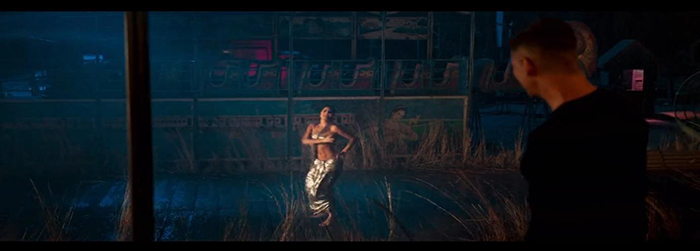
Figure 5. Male gaze and the dancing female body. Source. Still from Sooryavanshi, 1:15:50. Since the male body cannot be an object of desire under the male gaze in a heterosexual and patriarchal society, its erotic function is suppressed,[60] and it is infused with bravery and strength. Contrary to the male dancing body, which is used to 'reimpose masculine control and assure strength,' the female dancing body is vulnerable to the male gaze and objectification.[61] Even though all bodies are gendered from the commencement of their social existence,[62] the social approaches towards them are different. Female counterparts do not acquire as much public space as do the heroes, and the screen time allotted to female leads is very limited in each film. However, the female lead in Sooryavanshi appears for a longer duration in a dance sequence unlike her minimal role in the plot. The dancing female body is thin, scantily clad and made to dance in the rain which further exacerbates her female form, with an attempt to get the hero's attention (see Figure 5). Contrary to the powerful athletic moves of the hero in dance sequences, the female body is hypersexualised, and becomes a projection of the visual pleasure of heterosexual men.[63] The lens works as a male-gaze to position the woman on the screen in just the way that patriarchal society wants to see a female body, that is, as a sexual object. In a similar vein, Mulvey discusses how 'physical beauty' in terms of the female body is interpreted solely due to its treatment as an object. The male gaze here (see Figure 5) or the form of looking 'builds up the physical beauty of the object, transforming it into something satisfying in itself.'[64] As a result, the female body becomes an object devoted to the sensual gratification of heterosexual male fantasies. Within a consumer culture, the body becomes a site for pleasure and desires. And the closer it is to idealised images of 'youth, health, fitness and beauty,' the higher is its exchange value.[65] Even though each body works as capital under neoliberalism, the focus of the paper is on the male body. We argue that cinematic representations of the hero in which a hypermasculine corporeality is built increases the visual appeal of the film. Our argument resonates with Anne Ciecko's statement that the 'hero' in Bollywood is both a consumer agent and a commodity, who sings, dances and fights with an excess of charisma and effect.[66] Moreover, the consumption of hypermasculine body leads to a re-description of masculinity by shaping the popular view, since subjectivities and perceptions are constructed by what we consume.[67] As a result, visual and aesthetic dominance of these 'commodified' bodies render the 'other' bodies invisible, and the 'other' bodies are bodies of poor men or migrant men, considered non-normative and effeminate men in a neoliberal 'new' India.[68] Display of unwarranted violence The number of action scenes, fight sequences and stunts integral to cop movies is excessive. Such scenes represent a hero's fearlessness, bravery, courage and aggression, and they are used to establish the hero as an 'iconic image of male strength and resilience which elaborate an idealized masculinity.'[69] However, this paper argues that action sequences corroborated with exaggerated displays of violence and stunts in the male universe lead to a larger-than-life representation of the hero. 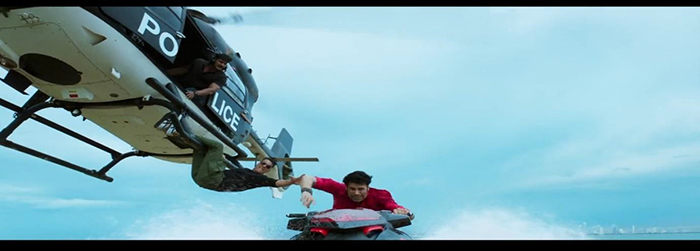
Figure 6. Dangerous stunt displayed by the hero. Source. Still from Sooryavanshi, 1:24:57. This particular shot (see Figure 6) captures Sooryavanshi performing an extremely dangerous stunt by hanging from the helicopter to arrest the suspect involved in a terror attack. The visual presentation of the stunt is done in such a way that it captures the hero extending his left hand diagonally to catch the culprit while balancing his body with the rest of his limbs (see Figure 6). The stunt displays masculine strength by the precise movements of the limbs, focused timings and rapidity yielding a larger-than-life representation of the hero to create maximum effects on viewers.[70] Furthermore, the hero's hypermasculine image is established by the long-choreographed action sequence, which begins with the hero on a bike and then on a helicopter to chase down the criminalised body. Out of four subscales of the Hypermasculinity Inventory, putting the hero in danger and his attitude towards 'danger as exciting'[71] can be studied as one of the strategies carried out to establish the hero as a larger-than-life character, who protects the nation without waiting for orders. The final scene of Sooryavanshi reiterates the same idea, when three officers come together and kill the terrorists on the spot without any legal proceedings. Such hypermasculine physical and sexual aggressiveness relate to the ideology of machismo,[72] which is understood as a 'hypermasculine form of a socially inherited gender-ideological script.'[73] Therefore, the ideology of machismo refers to a set of beliefs, which affirms male dominance through characteristics like virility, muscularity and physical aggression, and it forms the world view that exalts the aforementioned traits as being the true essence of men.[74] The macho personality of the cop hero is emphasised with characteristics like aggression, virility and violence in each movie. 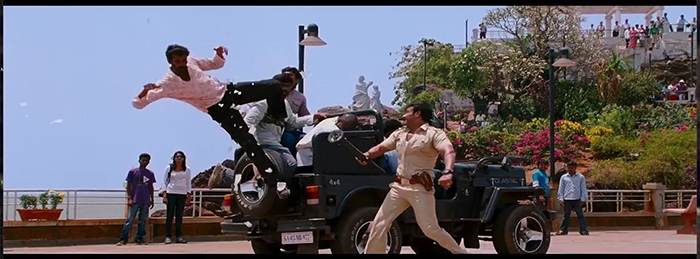
Figure 7. Hero as man-of-action. Source. Still from Singham, 1:15:55. These cop movies frequently portray action sequences in accordance with American 'man-of-action' heroic models, which show the hero as defying the organisation's rules but ultimately proving to be the only one capable of vanquishing the villain and re-establishing social order despite conflicts with his superiors.[75] Similarly, Singham, in his mission to extinguish the corrupt minister Jaykant Shikre, is faced with opposition from the police department, where his superiors are equally influenced by Shikre's power. However, to legitimise his power in such a restrictive, devaluing space that endorses corruption, the hero imbibes the performance of hypermasculinity. As a result, the hypermasculine corporeality that he induces metaphorically becomes a loaded gun 'forever at his own disposal' to exercise violence over other bodies.[76] The hypermasculine hero defeats Shikre's troops on the road (see Figure 7) without any assistance. Although they are on a moving automobile, Singham matches their speed, and uses one hit to launch a man upward (see Figure 7). The fighting sequence reflects Zaitchik and Mosher's emphasis on 'violence as manly'[77] and as one of the traits of hypermasculinity. Additionally, they have established hypermasculinity to be a product of 'punitive socialization' under the ideology of macho-culture.[78] Although violence is used by the hero to restore moral order, it has a destructive element associated with hypermasculinity, since it disregards rules of law in any civilised society. 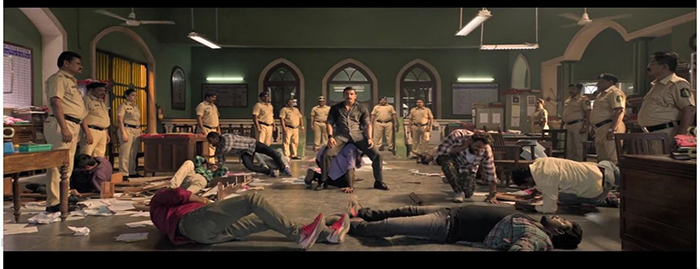
Figure 8. Display of authority and dominance by the hero. Source. Still from Simmba, 1:27:46. The portrayal of the hero as a hypermasculine man, and woman as a damsel in distress gave rise to the utilisation of sexual violence as a plot device in Bollywood.[79] Similarly, in Simmba the rape and murder of Akriti transforms the cop hero from a corrupt police officer to an honest one in order to avenge her death. Moreover, as Lalitha Gopalan argues, although the enforced interruption of camera during the rape scene protects the female from the male gaze and negates the victim's point of view, the film celebrates the overpowering revengeful acts of violence by the heroes.[80] In a similar vein, Simmba's deed of vengeance, with combat scenes and the murder of the rapists, is presented in a heroic light. When Simmba is attacked by Durva Ranade's men (the rapists' elder brother and main antagonist), a larger-than-life effect is added to the combat by placing the hero against eight men. In the end, the triumphant hero sits on a defeated man in the centre while his other defeated enemies lie on the ground (see Figure 8). Other cops surround the male hero, but in contrast, the hero's hypermasculine body strategically standing aside denotes authority, power and potency—a manifestation of hegemonic masculinity (see Figure 8). According to R.W. Connell and James Messerschmidt, hegemonic masculinity is the 'pattern of practices' that embodies the 'most honoured way of being a man, 'and determines the positions of all the men in relation to it and thus legitimises the subordination of women to men globally.[81] Furthermore, in the hierarchical structure that hegemonic masculinity forms between different types of masculinity, few men embodying archaic forms of masculinity are seen as leaders.[82] The leader image of cop hero in the scene (see Figure 8)remains unchallenged and is justified by qualities associated with traditional men in patriarchal society, such as strength, virility and violence.[83] Since within the hierarchy of masculinities there is a pattern of hegemony perpetuated through 'cultural consent, discursive centrality, institutionalisation, marginalisation or delegation of alternatives,'[84] the representational politics endows the hero with culturally accepted norms of ideal masculinity, such as, aggression, emotional stoicism, toughness and courage. 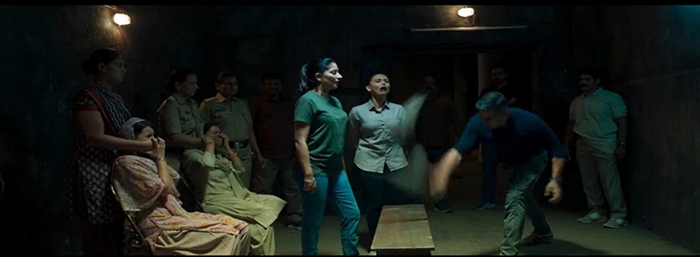
Figure 9. A shot in which violence against women is simulated. Source. Still from Sooryavanshi, 1:34:26. In the male universe, although the fight sequences do not involve women, the possibility of their defiled bodies poses a threat to the men. In Sooryavanshi when Usmani (who is associated with the terrorist chief) refuses to divulge any information in police custody, his daughters are brought to the cell next to his, and a fake enactment of violence is performed on their bodies. The wooden bench becomes the women's collective body, the belts become the weapons, the women police officers are instructed to cry out 'abbu'[85] (an address to their father) when his real daughters are forcibly silenced (see Figure 9). In an attempt to secure his daughters' honour Usmani agrees to tell the truth. Even though women's bodies are not directly utilised to perpetrate violence, the act is performed with a fundamental ideology that women are the best weapons against any man. The scene also reflects the patriarchal idea that upholding women's dignity is inextricably linked to manhood. Therefore, women, in these films, acquire symbolic roles either to be 'deified and defended or disgraced and humiliated,'[86] whereas men become national heroes since nationalism is considered, as Cynthia Enloe reminds us, a product of 'masculinised memory, masculinised humiliation, and masculinised hope.'[87] Hero as the protector This section foregrounds the role of the hero as the protector of the nation and women as a common trope in Rohit Shetty's films. Interestingly, without any doubt or anxiety over his actions, the cops shoulder the responsibility of upholding a crumbling and chaotic society. In Sooryavanshi, the hero is presented not only as an antidote to terror attacks, but also as a mouthpiece for communal harmony. With the evolution of Bombay cinema from the 1950s to the 1980s, the male star has emerged as a 'signifier of immanent and transcendent nationhood.'[88] Accordingly, the corporeal figuration of the male hero has been consistently portrayed as an impersonation of the morality, ideology and politics of the nation and the state.[89] Sooryavanshi, like many Bollywood movies, uses long standing religious separation between two communities and their eventual union, in order to appeal to emotions of the audience in the state and beyond. The political economy-based approach to cultural texts illustrates how media markets have been responsible for transferring nationalist ideology across continents.[90] Therefore, the depiction of religious conflict with a hero who challenges it may attract more viewers on a global stage. It is notable that only by rendering the religious gap visible, can the movie arouse the national sentiment of the audience after bringing two communities together in the wake of a terrorist attack. One scene where Muslim men come to help the Hindu priest place the idol of Ganesh in a safe place (see Figure 10), the background music Chhodo kal ki bateein, kal ki baat purani … Hum Hindustani (Let the past go, for the past is old … We are Indians)[91] makes the message of the movie clear. 
Figure 10. Representation of religious harmony. Source. Still from Sooryavanshi, 1:57:05. The image of the hero as protector goes along with women being used as ammunition to threaten the hero. And for the hero, Rai notes, the anxiety of violated and a raped wife-sister-daughter is integral to the portrayal of possessive and protective masculinity.[92] The body of the woman becomes the site for violence in the struggle between the villainous force and the masculine hero. In Sooryavanshi, at the ATS headquarters Veer Sooryavanshi's wife is carried by the terrorists with RDX planted on her body in order to blackmail the officer/the hero (see Figure 11). In the nation space, women are either elevated or disgraced, and in both the cases men defend their honour, and their freedom.[93] The same ideology leads to the propagation of violence on the bodies of women by villains, which works as a strategy to enhance the importance of the male protector. Moreover, the portrayal of women vulnerable to violence, as opposed to powerful masculine heroes, reflects the cinematic representation of gender dichotomy: women are cast in the roles of the protected ones and male characters are the violent protectors.[94] Consequently, the male hero is larger, stronger in appearance, and emotionally less vulnerable, whereas women appear as victims requiring salvation.[95] This gender dichotomy used in films is encoded with the ideology of hegemonic masculinity, which refers to a position of authority and dominance in relation not only to other masculinities but also to the 'gender order as a whole.'[96] According to Connell, hegemonic masculinity is a 'configuration of gender practice' that embodies the answer to the problem of the legitimacy of patriarchy, which guarantees the dominant position of men and the subordination of women.[97] Equivalently, the female characters are delineated with their voices repressed, their points of view ignored, their agency is minimised, and their professional significance is side-lined. Additionally, minimal screen time is given to women where they are used only as romantic interests, or as possible threats against the hero. The hero is the centre of the plot, with supreme qualities attributed to him as their protector. 
Figure 11. Female body used as a weapon by the terrorists. Source. Still from Sooryavanshi, 2:03:01. The glorification attached to the protector is repeated throughout. For instance, in Singham, when roadside goons sexually assault the girl, rip off a piece of cloth from her shoulder and snatch away her scarf (a symbol of honour), she does not protest. Rather, she is shown with her head hung down in shame incapable of protecting herself. In contrast, the angry cop hero is foregrounded, ready to avenge the physical assault (see Figure 12). After a long fight sequence on the road using his belt as a weapon, the victorious hero places the seized scarf back on the girl's shoulder. In a way, it symbolises the restoration of a woman's honour by the hero. Such a portrayal of women in Bollywood is problematic because it reinforces patriarchal practices and male fantasies about women.[98] It validates the belief that women are submissive to patriarchal norms, that they live chaste lives , practice self-sacrifice as a moral duty, and rarely do they exhibit their agency to question dominant patriarchal practices; rather they reside within the institutional pattern and expectation of marriage.[99] 'The pure body of the domesticated woman' becomes the central icon of the honourable family that needs to be protected, and works as a strategy to justify male violence in the film.[100] In addition to this, such representational politics of female characters reflect Connell's conceptualisation of 'emphasised femininity,' which denotes those forms of femininity that are functional in a complementary, compliant way, and accommodate a 'subordinate relationship with hegemonic masculinity.'[101] Lauren Menzie extends this concept to digital space in her work, and demonstrates how emphasised femininity is amenable to 'conditions of heteropatriarchy,' conformable to the male gaze, and constitutes part of the 'acceptable' bodily form.[102] This notion of emphasised femininity is useful in understanding the sustainability of hegemonic masculinity in the three movies under discussion. 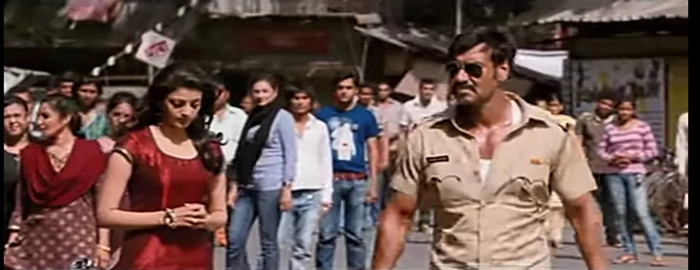
Figure 12. Representation of the hero as the protector. Source. Still from Singham, 0:32:32. In Singham, the physical dominance of the male hero is contrasted with the relative weakness of conventional womanhood[103] (see Figure 12), as a result of which is a demonstration of physical toughness of the male hero in a way that corresponds to hypermasculinity. Even though 'calloused sex towards women' is shown by the goons and villains, the male hero emulates traits of hypermasculinity, such as 'violence as manly,' 'danger as exciting,' 'toughness as self-control' of emotions,—all requirements of being the protector.[104] Furthermore, 'physical strength, the ability to use interpersonal violence in the face of conflict, and authority'[105] are paired with complementary inferior feminine characteristics, such as 'physical vulnerability, an inability to use violence effectively, and compliance'[106] to establish the hegemonic masculinity of the hero. Even though not all men and women embody these characteristics, masculinity and femininity in gender hegemony establish symbolic meanings for the relationship between men and women.[107] These symbolic meanings provide the rationale for 'social relations' which, in its re-enactment, ensures the ascendancy and dominance of men.[108] Moreover, symbolic meanings are hidden in plain sight. They constitute a social structure, legitimise 'unequal gender relations between men and women, masculinities and femininities, and among masculinities' and sustain hegemonic masculinity as contingent, provisional, omnipresent locally, regionally, globally,[109] one of the manifestations of which is patriarchy.[110] Conclusion The present analysis has focused on the portrayal of cop-heroes in three films by Rohit Shetty, where the persistent performance of masculinity with aggression, violence, overachieving ambition, physical strength, emotional detachment, corresponds to a heroic image that is hegemonic, and hypermasculine in nature. In addition to this, the paper has contended that such politics of representation incorporated with mainly three aspects: projection of powerful male body; display of unwarranted violence; and hero as a protector of the women and nation, are integral to the process of commodification, where a certain type of masculinity is used as a commodity for the making of commercialised films. Moreover, the process of commodification ensues as a combined effect of the filmmaker's personal ideology, a money-making strategy, and the demands of the neo-liberal consumerist market of the Hindi cinema industry. Additionally, the films attribute a position of dominance to heroic masculinity, which adheres to a larger paradigm of capitalist patriarchy. Capitalist patriarchy is inherent in neoliberalism and endorses unevenness in economic development and even though it pushes men bereft of equal opportunities to the margins, it ascertains that men not only in positions of 'power' but also in subordinate locations benefit from the wider subordination of women to men, in terms of their greater access to employment, capital and public space.[111] The films under focus reinforce this ideology through the repeated rendition of the male hero as a protector of the women and the nation. Consequently, it leads to the reception of an 'ideal form of masculinity' among the audience, as the media serves to construct masculinities that play a significant role in cultural definitions of masculinity.[112] Since masculinity is a relational concept with femininity,[113] and the 'collective power of men' rests not only on structures of power but also on the internalisation and reproduction of the conceptualisation of men's power,[114] the mass production and distribution of hegemonic and hypermasculine representation results in the perpetuation and celebration of the patriarchal image of man, and the repression of 'others.' In addition to the image of hero as a protector, the display of unwarranted violence in fight sequences projects a larger-than-life cop hero. Unlike the real cop whose power is regulated by both the law and a stringent legal system that also protects the rights of the criminal, cop hero is a hypermasculine man, who can singlehandedly control the situation and overpower the villains with violence. Such a commoditised powerful male figure shapes the popular view of masculinity in Indian society and is considered to be an aspirational referent. As a result, violence as a trait of masculinity is lauded and normalised in the public's consciousness. Additionally, in the consumerist culture, the use of cinematic images of the heterosexual powerful male body as a commodity and its wide circulation leads to the promotion of an 'ideal' body type that renders other bodies invisible. Contrary to the heteronormative narrative that re-institutionalises an already established patriarchy in Indian society, alternative representations of men with emotional vulnerability, marginalised masculinity in terms of caste, class, homosexuality, effeminate and non-normative masculinities, and women with equal agency and autonomy should be considered in the narratives of mainstream Bollywood movies. This reversal would subsequently help reshape the collective ideology of viewers. Since the focus of this paper is limited to heterosexual masculinity displayed by cop heroes, it points to further scope for research on alternative representations of masculinity in Bollywood. Notes [1] Maria Pramaggiore and Tom Wallis, 'Preface,' in their Film: A Critical Introduction, xii–xiv, Boston, MA: Pearson Allyn and Bacon, 2008, specifically p. xii. [2] Max Horkheimer and Theodor W. Adorno, 'The Culture Industry: Enlightenment as Mass Deception,' in Dialectic of Enlightenment Philosophical Fragments, ed. Gunzelin Schmid Noerr, trans. Edmund Jephcott, 94–136, Stanford, CA: Stanford University Press, 2002, specifically p. 95. [3] Charlie Walker and Steven Roberts, 'Masculinity, Labour and Neoliberalism: Reviewing The Field,' in Masculinity, Labour and Neoliberalism: Working Class Men in International Perspective, ed. Charlie Walker and Steven Roberts, 1–28, Global Masculinities. London: Palgrave, 2017, specifically p. 1, accessed 16 October 2023. [4] Wendy Brown, Undoing the Demos: Neoliberalism's Stealth Revolution, Cambridge, MA: MIT Press, 2015, p. 31. [5] Michael Hardt and Antonio Negri, Empire, Cambridge: Harvard University Press, 2000, p. 24. [6] R.W. Connell, Jeff Hearn and Michael S. Kimmel, 'Introduction,' in Handbook of Studies on Men & Masculinities, ed. Michael S. Kimmel, Jeff Hearn and R.W. Connell, 1–12, Thousand Oaks, CA: Sage, 2005, specifically p. 9. [7] Nancy Lindisfarne and Jonathan Neale, 'Masculinities and the lived experience of neoliberalism,' in Masculinities under Neoliberalism, ed. Andrea Cornwall, Frank Karioris and Nancy Kindisfarne, 29–50, London: Zed Books, 2016. [8] Walker and Roberts, 'Masculinity, Labour and Neoliberalism,' p. 4. [9] Vinodh Venkatesh, 'Introduction: The Body as Capital,' in theirThe Body as Capital: Masculinities in Contemporary Latin American Fiction, 3–14, Tuscon, AZ: The University of Arizona Press, 2015, specifically p. 6. [10] Shannon Philip, Becoming Young Men in a New India: Masculinities, Gender Relations and Violence in the Postcolony, New Delhi: Cambridge University Press, 2022, p. 3, doi: 10.1017/9781009158725. [11] Amrita Goswami, '"New Bollywood" and the emergence of a "Production House" culture,' South Asian Popular Culture 14(3) (2016): 185–97, specifically p. 185, doi: 10.1080/14746689.2017.1294805. [12] Ashish Rajadhyaksha, 'The "Bollywoodization" of the Indian cinema: Cultural nationalism in a global arena,' Inter-Asia Cultural Studies 4(1) (2003): 25–39, specifically p. 28, doi: 10.1080/1464937032000060195. [13] Margaret Jane Radin and Madhavi Sunder, 'Introduction: The Subject and Object of Commodification,' in Rethinking Commodification: Cases and Readings in Law and Culture, ed. Martha M. Ertman and Joan C. Williams, 8–33, Critical America 52, New York, NY: New York University Press, 2005, specifically p. 9. [14] Karl Marx, Capital: A Critique of Political Economy, Volume I, Book One: The Process of Production of Capital, trans. Samuel Moore and Edward Aveling, ed. Frederick Engels, Moscow: Progress Publishers, 2015 [1887], p. 27, accessed 12 Nov.2022. [15] Jernej Prodnik, 'Note on the Ongoing Processes of Commodification: From the Audience Commodity to the Social Factory,' triple C: Communication, Capitalism & Critique. Journal for a Global Sustainable Information Society 10(2) (2012): 274–301, specifically p. 296, doi: 10.31269/triplec.v10i2.409. [16] Venkatesh, 'Introduction: The Body as Capital,' p. 4. [17] Zanjeer, 147 minutes, 1973, produced and directed by Prakash Mehra, YouTube, accessed 25 Oct. 2022; Deewaar, 176 minutes, 1975, produced by Gulshan Rai, directed by Yash Chopra, ZEE5, accessed 26 Oct. 2022, cited in Janmejay Kumar Tiwari, 'Indian Classical Movies: A Cultural Heritage,' Central Asian Journal of Literature, Philosophy and Culture 3(88) (2022): 87–95, specifically p. 92, accessed 16 Oct. 2023. [18] Sholay, 204 minutes, 1975, produced by G.P. Sippy, directed by Ramesh Sippy, ZEE5, accessed 25 Oct. 2022. [19] Tirangaa, 134 minutes, 1993, produced and directed by Mehul kumar, ZEE5, accessed 25 Oct. 2022. [20] Main Khiladi Tu Anari, 184 minutes, 1994, produced by Champak Jain, directed by Sameer Malkanand, Prime Video, accessed 19 Oct. 2022. [21] Kurukshetra, 185 minutes, 2000, produced by Pravin Shah, directed by Mahesh Manjrekar, Hotstar,, accessed 23 Oct. 2022. [22] Gangaajal, 157 minutes, 2003, produced by Prakash Jha, Monmohan Shetty,and Praveen Nischol, directed by Prakash Jha, Hotstar, accessed 21 Oct. 2022. [23] Rowdy Rathore, 157 minutes, 2012, produced by Sanjay Leela Bhansali, and Ronnie Screwvala, directed by Prabhu Deva, NETFLIX, accessed 3 Nov. 2022. [24] Jeffrey A. Brown, 'Bullets, Buddies, And Bad Guys: The "Action-Cop" Genre,' Journal of Popular Film and Television 21(2) (1993): 79–87, specifically p. 80, doi: 10.1080/01956051.1993.9944235. [25] Singham, 135 minutes, 2011, produced by Reliance Entertainment, directed by Rohit Shetty, Prime Video, accessed 1 Nov. 2022. [26] Simmba, 158 minutes, 2018, produced by Hiroo Yash Johar, Rohit Shetty, Apoorva Mehta and Karan Johar, directed by Rohit Shetty, ZEE5, accessed 1 Oct. 2022. [27] Sooryavanshi, 145 minutes, 2021, produced by Hiroo Yash Johar, Aruna Bhatia, Rohit Shetty, Apoorva Mehta and Karan Johar, directed by Rohit Shetty, NETFLIX, accessed 10 Oct. 2022. [28] Praseeda Gopinath, '"A feeling you cannot resist": Shah Rukh Khan, affect, and the re- scripting of male stardom in Hindi cinema,' Celebrity Studies 9(3) (2018): 307–25, specifically p. 312, doi: 10.1080/19392397.2017.1411202. [29] Meraj Ahmed Mubarki, 'Body, masculinity and the male hero in Hindi cinema,' Social Semiotics 30(2) (2020): 225–53, specifically p. 226, doi: 10.1080/19392397.1411202. [30] Michael S. Kimmel, Manhood in America: A Cultural History, New York, NY: Free Press, 1996; Lee Clark Mitchell, Westerns: Making the Man in Fiction and Film, Chicago, IL: University of Chicago Press, 1996, cited in Douglas B. Holt and Craig J Thompson, 'Man-of-Action Heroes: The Pursuit Of Heroic Masculinity In Everyday Consumption,' Journal of Consumer Research 31(2) (2004): 425–40, specifically p. 426. [31] Steve Neale, 'Masculinity as Spectacle: Reflection on Men and Mainstream Cinema,' Screen 24(6) (1983): 2–17, specifically p. 8, doi: 10.1093/screen/24.6.2. [32] Rebecca Coleman, The Becoming of Bodies: Girls, Images, Experiences, Manchester: Manchester University Press, 2009, p. 1, accessed 17 Oct. 2023. [33] Nandini Bhattacharya, Hindi Cinema: Repeating the Subject, New York, NY: Routledge, 2013, p. 159, accessed 17 Oct. 2023. [34] Michiel Baas, 'Muscles, masculinity and middle classness,' in Routledge Handbook of Contemporary India, ed. Knut A. Jacobsen, 444–56, New York, NY: Routledge, 2016, specifically p. 444. [35] Philip, Becoming Young Men in a New India, p. 28. [36] Mubarki, 'Body, masculinity and the male hero in Hindi cinema,' p. 226. [37] Gopinath, 'A feeling you cannot resist,' p. 312. [38] R.W. Connell, Masculinities, Cambridge: Polity Press, 1995, p. 77. [39] R.W. Connell and James W. Messerschmidt, 'Hegemonic Masculinity: Rethinking the Concept,' Gender & Society 19(6) (2005): 829–59, doi: 10.1177/0891243205278639; quoted in Nathian Shae Rodriguez, Jennifer Huemmer and Lindsey E. Blumell, 'Mobile masculinities: An investigation of networked masculinities in gay dating apps,' Masculinities and Social Change 5(3) (2016): 241–67, specifically p. 244, doi: 10.17583/MCS.2016.2047. [40] Santiago Fouz-Hernández and Alfredo Martínez-Expósito, Live Flesh: The Male Body in Contemporary Spanish Cinema, London: IB Tauris, 2007, p. 85, accessed 16 Oct. 2023. [41] R.W. Connell, Which Way is Up: Essays on Sex, Class and Culture, Sydney: Allen and Unwin, 1983, specifically pp. 185, 186 and 239, accessed 16 Oct. 2023. [42] Philip, Becoming Young Men in a New India, pp. 61–62. [43] Laura Mulvey, 'Visual Pleasure and Narrative Cinema,' Screen 16(4) (1975): 6–18, doi: 10.1093/screen/16.3.6. [44] Moses May-Hobbs, 'Jacques Lacan: Explaining the Imaginary, the Symbolic, and the Real,' The Collector, 20 September 2023, accessed 16 Oct.2023. [45] Mulvey, 'Visual Pleasure and Narrative Cinema,' p. 10. [46] Jean Baudrillard, The Consumer Society: Myths and Structures, trans. Chris Turner, Thousand Oaks, CA: Sage Publications, 2017, p.129. [47] Mubarki, 'Body, masculinity and the male hero in Hindi cinema,' p. 246. [48] Ranjani Mazumdar, 'Rage on Screen' in their Bombay Cinema: An Archive of the City, 1–40, Minneapolis, MN: University of Minnesota Press, 2007, specifically pp. 9–12. [49] Mazumdar, 'Rage on Screen,' pp. 9–12. [50] Mubarki, 'Body, masculinity and the male hero in Hindi cinema,' p. 226. [51] Philip, Becoming Young Men in a New India, p. 28. [52] Mubarki, 'Body, masculinity and the male hero in Hindi cinema,' p. 246. [53] Matt C. Zaitchik and Donald L.Mosher, 'Criminal Justice Implications of the Macho Personality Constellation,' Criminal Justice and Behavior 20(3) (1993): 227–39, doi: 10.1177/0093854893020003001. [54] Donald L. Mosher and Mark Sirkin, 'Measuring a Macho Personality Constellation,' Journal of Research in Personality 18(2) (1984): 150–63, doi: 10.1016/0092-6566(84)90026-6. [55] Zaitchik and Mosher, 'Criminal Justice Implications of the Macho Personality Constellation,' pp. 232–33. [56] Singham, 135 minutes, 2011,produced by Reliance Entertainment, directed by Rohit Shetty, accessed 1 Nov. 2022, 00:09:09–00:09:12. [57] Philip, Becoming Young Men in a New India, p. 68. [58] Simmba, 158 minutes, 2018, produced by Hiroo Yash Johar, Rohit Shetty, Apoorva Mehta, and Karan Johar, directed by Rohit Shetty, online: accessed 1 Oct. 2023, 00:07:09–00:09:00. [59] Maura Keefe, 'Is Dance a Man's Sport Too: The performance of Athletic-Coded Masculinity on the Concert Dance Stage,' in When Men Dance: Choreographing Masculinities Across Borders, ed. Jennifer Fisher and Anthony Shay, 91–106, New York, NY: Oxford University Press, 2009, specifically p. 91, doi: 10.1093/acprof:oso/9780195386691.001.0001. [60] Neale, 'Masculinity as Spectacle,' p. 8. [61] Anindita Das, 'Choreographed Masculinity: Representations in Twenty-First Century Bollywood,'Journal of Department of English, Vidyasagar University 14 (2021): 36–45, specifically p. 40, accessed 16 Oct. 2023. [62] Sara Salih, 'On Judith Butler and Performativity,' in Sexualities and Communication in Everyday Life: A Reader, ed. Karen E. Lavaas and Mercilee M. Jenkins, 55–67, Thousand Oaks, CA: Sage Publications, 2007, specifically p. 55. [63] Parul Jain, Enakshi Roy, Nisha Garud and Imran Mazid, 'Sexuality and substance abuse portrayals in item songs in Bollywood movies', South Asian Popular Culture 17(1) (2019): 15–29, specifically p. 18, doi: 10.1080/14746689.2019.1585605. [64] Mulvey, 'Visual Pleasure and Narrative Cinema,' p. 14. [65] Mike Featherstone, 'The Body in Consumer Culture,' Theory, Culture &Society 1(2) (1982): 18–33, cited in Pranta Patnaik, '"Fat" Gay Men's Negotiation of Embodiment, Culture, and Masculinity,' in Masculinity and Its Challenges in India: Essays on Changing Perceptions, ed. Rohit Dasgupta and K. Moti Gokulsing, 93–105, Jefferson, NC: McFarland Incorporated Publishers, 2014, specifically p. 102. [66] Anne Ciecko, '"Superhit hunk heroes for sale: Globalization and Bollywood's gender politics,' Asian Journal of Communication 11(2) (2001): 121–43, specifically p.121, doi: 10.1080/01292980109364807. [67] Rohit Dasgupta and K Moti Gokulsing, 'Introduction: Perceptions of Masculinity and Challenges to the Indian Male,' in Masculinity and Its Challenges in India: Essays on Changing Perceptions, ed. Rohit Dasgupta and K. Moti Gokulsing, 5–25, Jefferson, NC: McFarland Incorporated Publishers, 2014, specifically p. 22. [68] Philip, Becoming Young Men in a New India, p.73. [69] Yvonne Tasker, 'Contested masculinities: The action film, the war film, and the Western,' in The Routledge Companion To Cinema & Gender, ed. Kristin Lene Hole, Dijana Jelaca, E. Ann Kaplan and Patrice Petro, 111–20, New York, NY: Routledge, 2016, specifically p. 111, accessed 16 Oct. 2023. [70] Mubarki, 'Body, masculinity and the male hero in Hindi cinema,' p. 246. [71] Zaitchik and Mosher, 'Criminal Justice Implications of the Macho Personality Constellation,' p. 232. [72] Donald L. Mosher, 'Macho Men, Machismo, and Sexuality,' in Annual Review of Sex Research 2(1991): 199–247, specifically p. 199. [73] Mosher, 'Macho Men, Machismo, and Sexuality,' p. 213. [74] Zaitchik and Mosher, 'Criminal Justice Implications of the Macho Personality Constellation,' p. 230. [75] Holt and Thompson, 'Man-of-action heroes: The pursuit of heroic masculinity in everyday consumption,' p. 429. [76] Mubarki, 'Body, masculinity and the male hero in Hindi cinema,' p. 246. [77] Zaitchik and Mosher, 'Criminal Justice Implications of the Macho Personality Constellation,' pp. 232–33. [78] Zaitchik and Mosher, 'Criminal Justice Implications of the Macho Personality Constellation,' p. 230. [79] Saurabh Samraat, 'Bollywood's Toxic Masculinity: The Problematic Portrayal of Men & Women in Popular Hindi Cinema,' International Journal of Law Management & Humanities 4(1) (2021): 424–31, specifically p. 425. [80] Lalitha Gopalan, Cinema of Interruptions: Action Genres in Contemporary Indian Cinema, London: British Film Institute, 2002, p. 48, cited in, Gary Needham, 'Review on Cinema of Interruptions: Action Genres in Contemporary Indian Cinema by Lalitha Gopalan,' Screen 45(2) (2004): 168–71, specifically p.169, doi: 10.1093/screen/45.2.168. [81] Connell and Messerschmidt, 'Hegemonic Masculinity: Rethinking the Concept,' p. 832. [82] Connell and Messerschmidt,' Hegemonic Masculinity: Rethinking the Concept,' pp. 829–59. [83] Philippa Gates, Detective Men: Masculinity and the Hollywood Detective Film, Albany, NY: State University of New York Press, 2006, p. 35. [84] Connell and Messerschmidt, 'Hegemonic Masculinity: Rethinking the Concept,' p. 841. [85] Sooryavanshi, 1:34:21–1:34:30. [86] Mubarki, 'Body, masculinity and the male hero in Hindi cinema,' pp. 247–48. [87] Cynthia Enloe, Bananas, Beaches, and Bases: Making Feminist Sense of International Politics, Berkeley, CA: University of California Press, 1990, p. 45, accessed 16 Oct. 2023. [88] Sumita S. Chakravarty, National Identity in Indian Popular Cinema 1947–1987, Austin: TX: University of Texas Press, 1993, p. 233, accessed 16 Oct. 2023. [89] Chakravarty, National Identity in Indian Popular Cinema 1947–1987, p. 234. [90] Murali Balaji and Khadeem Hughson, '(Re)producing borders and bodies: masculinity and nationalism in Indian cultural texts,' Asian Journal of Communication 24(3) (2014): 207–21, specifically p. 210. [91] Sooryavanshi, 1:55:55–1:57:18. [92] Amit S. Rai, 'Every Citizen is a Cop Without the Uniform: The Populist Outsider in Bollywood's New Angry Young Man Genre,' in interventions 8(2) (2006): 193–227, specifically p. 225, doi: 10.1080/13698010600781032. [93] Enloe, Bananas, Beaches, and Bases: Making Feminist Sense of International Politics, p. 45. [94] Carol M. Dole, 'The Gun and the Badge: Hollywood and the Female Lawman,' in Reel Knockouts: Violent Women in Film, ed. Martha McCaughey and Neal King, 78–105, Austin, TX: University of Texas Press, 2001, specifically p. 79, doi: 10.7560/752504-006. [95] Dole, 'The Gun and the Badge,' p.79. [96] R.W. Connell, 'Teaching the Boys: New Research on Masculinity, and Gender Strategies for Schools,' Teachers College Record 98(2) (1996): 206–36, specifically p. 209, doi: 10.1177/016146819609800203. [97] Connell, Masculinities, p. 77. [98] Jain, Roy, Garud and Mazid, 'Sexuality and substance abuse portrayals in item songs in Bollywood movies,' p. 16. [99] Jain, Roy, Garud and Mazid, 'Sexuality and substance abuse portrayals in item songs in Bollywood movies,' p. 16. [100] Rai, 'Every Citizen is a Cop Without the Uniform,' p. 205. [101] James W. Messerschmidt, Hegemonic Masculinity: Formulation, Reformulation, and Amplification, London: Rowman & Littlefield, 2018, p. 18. [102] Lauren Menzie, 'Stacys, Beckys, and Chads: the construction of femininity and hegemonic masculinity within incel rhetoric,' Psychology & Sexuality 13(1) (2022): 69–85, specifically p. 74, doi: 10.1080/19419899.2020.1806915. [103] Dole, 'The Gun and the Badge,' p. 79. [104] Zaitchik and Mosher, 'Criminal Justice Implications of the Macho Personality Constellation,' pp. 232–33. [105] Mimi Schippers, 'Recovering the Feminine Other: Masculinity, Femininity, and Gender Hegemony,' Theory and Society 36(1) (2007): 85–102, specifically p.91, doi: 10.1007/s11186-007-9022-4. [106] Schippers, 'Recovering the Feminine Other,' p. 91. [107] Schippers, 'Recovering the Feminine Other,' p. 91. [108] Schippers, 'Recovering the Feminine Other,' p. 91. [109] Messerschmidt, Hegemonic Masculinity: Formulation, Reformulation, and Amplification, p. 18. [110] Rohit Dasgupta and K Moti Gokulsing, 'Introduction: Perceptions of Masculinity and Challenges to the Indian Male,' p. 7. [111] Connell, Masculinities, cited in, Christine Beasley, 'Rethinking Hegemonic Masculinity in a Globalizing World,' Men and Masculinities 11(1) (2008): 86–103, specifically p. 92, doi: 10.1177/1097184X08315102. [112] Steve Craig, 'Considering Men and the Media,' in Men, Masculinity and the Media, ed. Steve Craig, 1–8, Thousand Oaks, CA: Sage Publications, 1992, specifically p. 3, doi: 10.4135/9781483326023. [113] Connell, Masculinities, p. 44. [114] Michael Kaufman, 'Men, Feminism, and Men's Contradictory Experiences of Power,' in Theorizing Masculinities, ed. Harry Brod and Michael Kaufman, 142–63, Thousand Oaks, CA: Sage Publications, 1994, specifically p. 146, doi: 10.4135/9781452243627. |

|